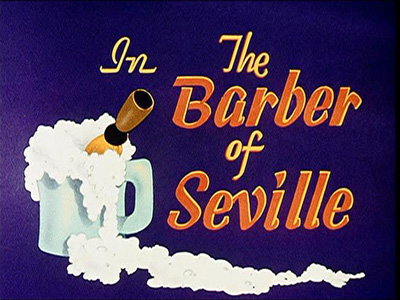- The Barber of Seville (cartoon)
Infobox Hollywood cartoon
cartoon_name = The Barber of Seville
series = Woody Woodpecker

caption =
director = James Culhane
story_artist =Ben Hardaway Milt Schaffer
animator = Verne HardingLes Kline Pat Matthews Emery Hawkins Rudy Zamora
Paul J. Smith
voice_actor = Ben Hardaway
musician =Darrell Calker Gioacchino Rossini
producer =Walter Lantz
studio =Walter Lantz Productions
distributor =Universal Pictures
release_date =April 22 ,1944
color_process =Technicolor
runtime = 7 min (one reel)
movie_language = English
preceded_by = "Ration Bored "
followed_by = "The Beach Nut "
imdb_id = 0151893"The Barber of Seville" is the tenth
animated cartoon short subject in the "Woody Woodpecker " series. Released theatrically onApril 22 ,1944 , the film was produced byWalter Lantz Productions and distributed by Universal Pictures.Plot synopsis
Woody arrives at "Tony Figaro's" barber shop in hopes of getting a "victory haircut" (a then-contemporary
World War II reference). Finding the shop's proprietor out for an Army physical, Woody attempts to cut his own hair and those of other customers with comic results. The first customer, a Native American, asks the woodpecker for "a quickshampoo ". What he gets instead, however, is a headdress reduced to abadminton shuttlecock by hot towels."You give chief the bird," the angry client remarks while holding the shuttlecock, "me give you scalp treatment!"
"Oh no, Chiefie," responds Woody. "Me give "you" scalp treatment!" With that, Woody bops the chief over the head with a mallet, and launches him out of the barber's chair and across the street, where he lands and becomes a
Cigar store Indian .The second customer is a burly Italian construction worker, who comes in and asks for "the whole works". Once Woody blow-torches the man's construction helmet off his head, he proceeds to lather his client's face, chin, mouth, and boots while singing Rossini's "
Largo al factotum ". Woody then produces a sharp razor and begins shaving the man. Woody elevates the barber's chair to the ceiling whiles singing anaria , allowing the man to fall to the ground and destroy the chair. Woody then begins liberally swinging the razor at his frightened client, who runs to escape him. A chase throughout the barbershop ensues - as Woody doubles the tempo of his singing - until the woodpecker corners the man in the barber's chair and proceeds to give him a shave and haircut at manic speed. The construction worker is dusted off and sent out the door on his way, but the angry client enacts a quick bit of revenge as Woody begins to laugh. The man picks Woody up and slings him through a glass window and back inside the shop, where the woodpecker lands and is bopped by shaving mugs falling from a broken shelf. As a last touch, thebarber's pole falls on Woody, whose head is seen caught and mangled inside the pole as the cartoon irises out.History
"The Barber of Seville" was the first cartoon to feature a more streamlined character design for Woody Woodpecker, courtesy of veteran animator
Emery Hawkins and art directorArt Heinemann . In prior shorts, Woody had had a more grotesque appearance, including buck teeth, a receding chin, and thick stubby legs. Heinemann removed these features, and restructured Woody's body to conform to the modern animation standards in use for characters such as those appearing inDisney and Warner Bros cartoons.In tandem with the use of the new Woody design, "The Barber of Seville" was the first Woody Woodpecker cartoon to use the standardized opening title card, animated by Hawkins, featuring Woody popping out of a log, asking "Guess Who?!", and delivering his trademark laugh. The audio for this opening sequence is lifted from Woody's first starring appearance in the 1941 cartoon "
Woody Woodpecker ", in which Woody was voiced byMel Blanc .Ben Hardaway , also the co-storyman on "Barber of Seville", provides Woody's speaking voice for the cartoon proper, with an unidentified singer performing as Woody's singing voice. Finally, "The Barber of Seville" was the first Woody cartoon directed by veteran animator James "Shamus" Culhane, who had been working on Lantz's "Swing Symphonies " for a year prior.A parody of
Gioacchino Rossini 's opera of the same name, "The Barber of Seville" is noted for its uses of speed, timing, and music synchronization. During the shaving of the second client, several shots are presented in rapid succession, some lasting only one-fourth of a second. Woody's demeanor and attitude are designed to match the music, during the famous "Figaro" portion of the tune, Woody splits into three, then four, then five instances of himself, in less than two seconds of screen time. Culhane later called "The Barber of Seville" "one of my most satisfying achievements as a director". [ Culhane, Shamus (1986). "Talking Animals and Other People". New York: Da Capo Press. ISBN 978-03-0680-830-2. Pg. 259.]By 1944, Rossini's opera was a staple of American cartoon humor, with a noted earlier use in the "
Looney Tunes " short "Notes to You" (1941) starringPorky Pig . Later cartoons to parody Rossini's music include "Rabbit of Seville " (Warner Bros. ) and "Magical Maestro " (MGM ). In 1994, "The Barber of Seville" was voted as number forty-three ofThe 50 Greatest Cartoons of all time, as voted by 1000 animation professionals and edited byJerry Beck .Notes
Wikimedia Foundation. 2010.
